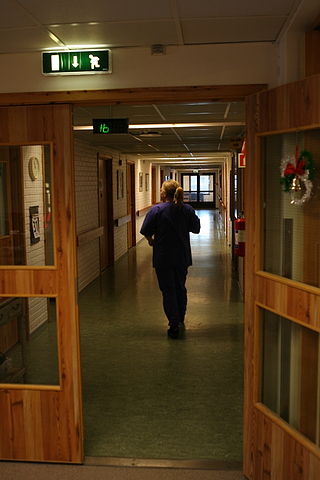Related Research Articles

Health care, or healthcare, is the improvement of health via the prevention, diagnosis, treatment, amelioration or cure of disease, illness, injury, and other physical and mental impairments in people. Health care is delivered by health professionals and allied health fields. Medicine, dentistry, pharmacy, midwifery, nursing, optometry, audiology, psychology, occupational therapy, physical therapy, athletic training, and other health professions all constitute health care. The term includes work done in providing primary care, secondary care, and tertiary care, as well as in public health.
Milton District Hospital is a community hospital built on 40 acres (16 ha) of land, located in Milton, Ontario, Canada. It is operated by Halton Healthcare Services, an organization which also operates Oakville-Trafalgar Memorial Hospital and Georgetown Hospital.
Patient advocacy is a process in health care concerned with advocacy for patients, survivors, and caregivers. The patient advocate may be an individual or an organization, concerned with healthcare standards or with one specific group of disorders. The terms patient advocate and patient advocacy can refer both to individual advocates providing services that organizations also provide, and to organizations whose functions extend to individual patients. Some patient advocates are independent and some work for the organizations that are directly responsible for the patient's care.

A nursing shortage occurs when the demand for nursing professionals, such as Registered Nurses (RNs), exceeds the supply locally—within a healthcare facility—nationally or globally. It can be measured, for instance, when the nurse-to-patient ratio, the nurse-to-population ratio, the number of job openings necessitates a higher number of nurses than currently available, or the current number of nurses is above a certain age where retirement becomes an option and plays a factor in staffing making the workforce in a higher need of nurses. The nursing shortage is global according to 2022 World Health Organization fact sheet.

The UCLA Jonathan and Karin Fielding School of Public Health is the graduate school of public health at UCLA, and is located within the Center for Health Sciences building on UCLA's campus in the Westwood neighborhood of Los Angeles, California. The UCLA Fielding School of Public Health has 690 students representing 25 countries, more than 11,000 alumni and 247 faculty, 70 of whom are full-time.

A certificate of need (CON), in the United States, is a legal document required in many states and some federal jurisdictions before proposed creations, acquisitions, or expansions of healthcare facilities are allowed. CONs are issued by a federal or state regulatory agency with authority over an area to affirm that the plan is required to fulfill the needs of a community.

Germany has a universal multi-payer health care system paid for by a combination of statutory health insurance and private health insurance.

In the post-Soviet era, the quality of Uzbekistan’s health care has declined. Between 1992 and 2003, spending on health care and the ratio of hospital beds to population both decreased by nearly 50 percent, and Russian emigration in that decade deprived the health system of many practitioners. In 2004 Uzbekistan had 53 hospital beds per 10,000 population. Basic medical supplies such as disposable needles, anesthetics, and antibiotics are in very short supply. Although all citizens nominally are entitled to free health care, in the post-Soviet era bribery has become a common way to bypass the slow and limited service of the state system. In the early 2000s, policy has focused on improving primary health care facilities and cutting the cost of inpatient facilities. The state budget for 2006 allotted 11.1 percent to health expenditures, compared with 10.9 percent in 2005.

Indonesia has drastically improved its health care in the past decade. Government expenditure on healthcare was about 3.1% of its total gross domestic product in 2018.
Kenya's health care system is structured in a step-wise manner so that complicated cases are referred to a higher level. Gaps in the system are filled by private and church run units.
The French health care system is one of universal health care largely financed by government national health insurance. In its 2000 assessment of world health care systems, the World Health Organization found that France provided the "best overall health care" in the world. In 2017, France spent 11.3% of GDP on health care, or US$5,370 per capita, a figure higher than the average spent by rich countries, though similar to Germany (10.6%) and Canada (10%), but much less than in the US. Approximately 77% of health expenditures are covered by government funded agencies.
Healthcare in Ukraine is part of a universal health care system largely built up as a successor of the Soviet healthcare system otherwise dismantled in 1991. The Ministry of Healthcare implements the state policy in the country in the field of medicine and healthcare.
Healthcare in Georgia is provided by a universal health care system under which the state funds medical treatment in a mainly privatized system of medical facilities. In 2013, the enactment of a universal health care program triggered universal coverage of government-sponsored medical care of the population and improving access to health care services. Responsibility for purchasing publicly financed health services lies with the Social Service Agency (SSA).

Woodilee Hospital was a psychiatric institution situated in Lenzie, East Dunbartonshire, Scotland.
Examples of health care systems of the world, sorted by continent, are as follows.
Ruth Roemer was an American lawyer and public health researcher who championed the importance of human rights in the field of public health.

Hospedia Ltd is a provider of bedside communication and entertainment units in UK hospitals which also sells clinical workflow solutions for NHS Trusts.
Zambia is a landlocked country in Sub Saharan Africa which experiences a burden of both communicable and non-communicable diseases. In line with WHO agenda for equity in health, it has adopted the Universal Health Coverage agenda to mitigate the challenges faced within the health sector. The Ministry of Health (MOH) provides information pertaining to Zambian health. The main focus of the Ministry of Health has been provision of uninterrupted care with emphasis on health systems strengthening and services via the primary health care approach.

Healthcare in Chennai is provided by both government-run and private hospitals. Chennai attracts about 45 percent of health tourists from abroad arriving in the country and 30 to 40 percent of domestic health tourists. The city has been termed India's health capital. Multi- and super-specialty hospitals across the city bring in an estimated 150 international patients every day. Factors behind the tourists' inflow in the city include low costs, little to no waiting period, and facilities offered at the speciality hospitals in the city.
Transinstitutionalisation is the phenomenon where inmates released from one therapeutic community move into other institutions, either as planned move or as an unforeseen consequence. For instance, when the residential mental hospitals in the United States were closed as the result of a political policy change, the prison population increased by an equivalent number.
References
- ↑ "Obituary: Milton I. Roemer, Pioneering UCLA Health Services Professor and Professional Who Defined Health Policy in U.S., Abroad". University of California, Los Angeles School of Public Health. 8 January 2001. Archived from the original on 4 March 2012.
- ↑ Shain, M; Roemer, MI (April 1959). "Hospital costs relate to the supply of beds". Modern Hospital . 92 (4): 71–3. PMID 13644010.
- ↑ Bovbjerg, Randall (1978). "Problems and Prospects for Health Planning: The Importance of Incentives, Standards, and Procedures in Certificate of Need". Utah Law Review. 83.
- ↑ "Roemer's Law of Demand". Opus1 Journal: The Journal of Undergraduate Research. 7 September 2005. Archived from the original on 7 January 2009.
- ↑ Shafrin, Jason (12 October 2006). "Roemer's law". Healthcare Economist.[ self-published source ]
- ↑ Powell, Enoch (1966). A new look at Medicine and Politics . Retrieved 1 July 2015.